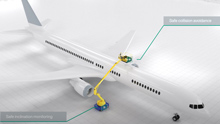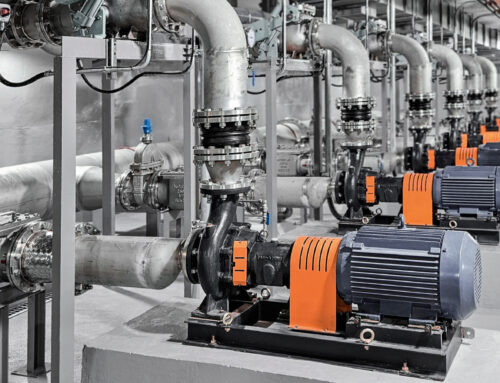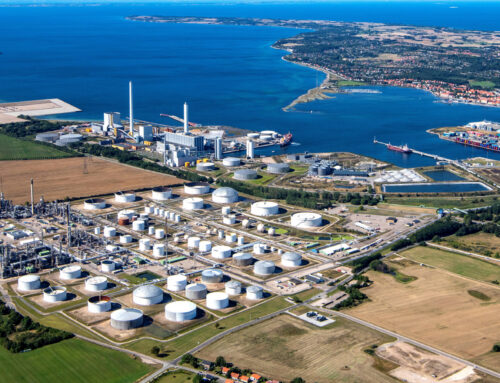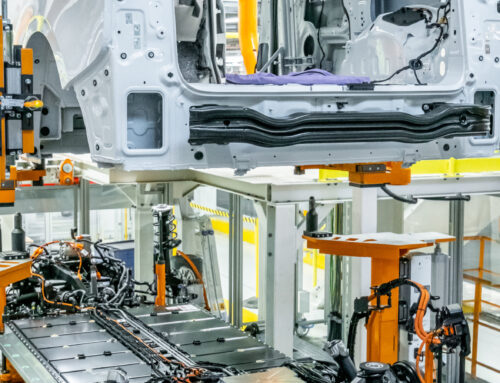July 22, 2021
Aircraft Collision Safely Ruled Out
In aviation, the safety of people and machines has the highest priority. This also applies to assembly and maintenance work on the aircraft fuselage. A multidimensional aerial work platform from HUBTEX Maschinenbau ensures safe maneuvering in all directions of movement with the help of 2-D LiDAR sensors R2100 from Pepperl+Fuchs.
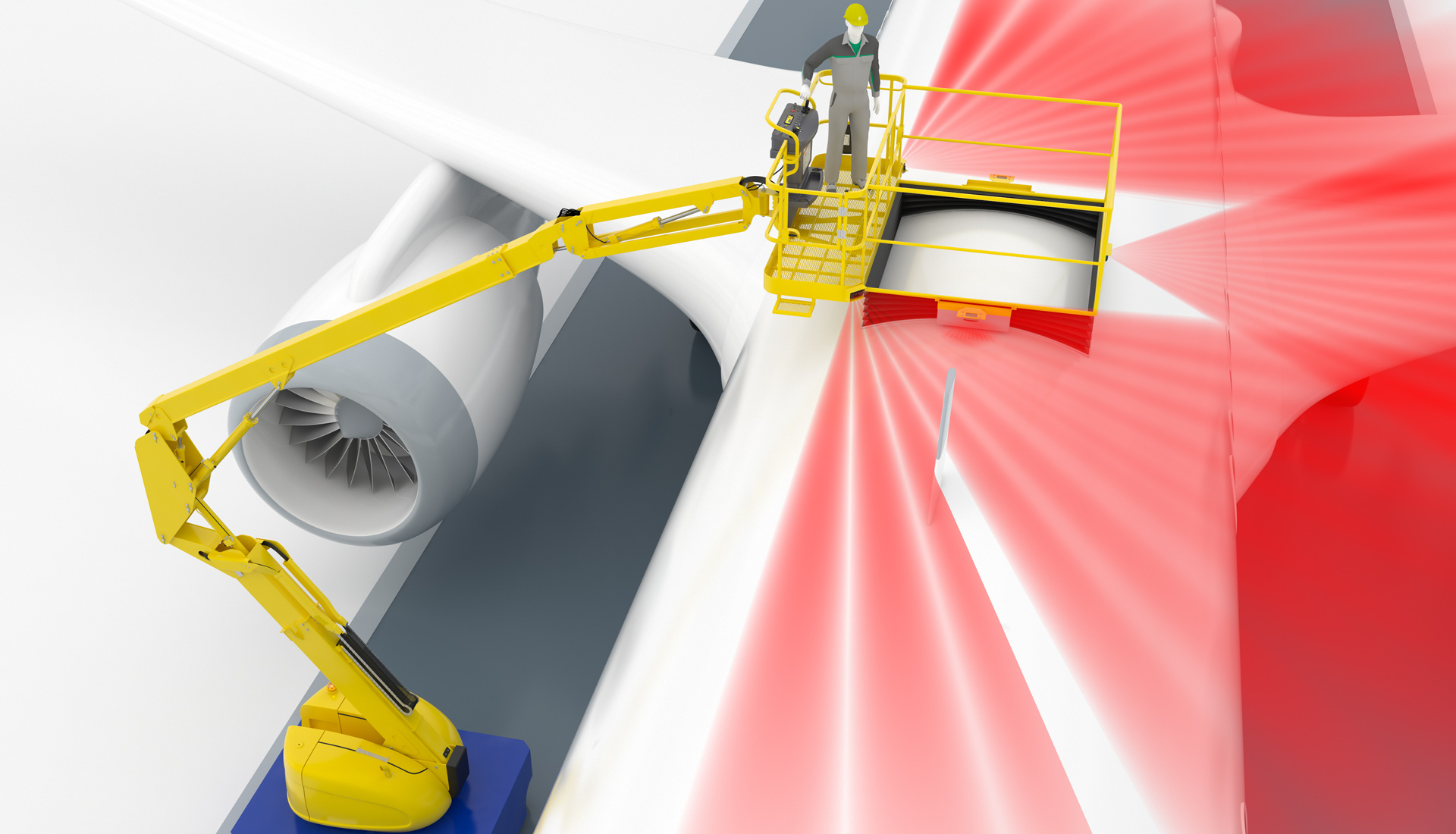
In addition to the ever-present safety considerations, it is part of the DNA of aircraft construction to save weight where possible. Modern materials mean that aircraft are now much lighter than predecessors from previous decades. New light-metal alloys and carbon-fiber reinforced composites in particular are really spurring on lightweight construction. However, special precautions need to be taken during assembly of external shells made of these material types. Improper contact may cause structural damage to the fuselage—something that often goes undetected by the naked eye. Uncontrolled mechanical contacts or even a collision with a heavy object could have fatal consequences. In this case, a safe warning and assistance system is a must to avoid collisions between the aerial work platform and the aircraft and to ensure the integrity of man and machine.
Any collisions with the fuselage must be ruled out, including manual operating errors. Working to this specification from its American customer, HUBTEX Maschinenbau GmbH & Co. KG has developed an innovative, multidirectional working platform for assembly tasks in aircraft construction. HUBTEX placed its trust in the Pepperl+Fuchs experts to provide the necessary safety-compliant sensor solution. To prevent collisions in three dimensions, the lifting platform was equipped with R2100 2-D LiDAR sensors. These multi-ray LED scanners always have the working platform's surroundings in view in all directions of movement and stop when they come too close to the fuselage. An inclination sensor signals in real time the safe positioning of the vehicle when the telescopic arm extends and the working platform is moved.
Three-Dimensional View
HUBTEX specializes in the manufacture of customized material handling equipment, mobile lifting platforms, and tailor-made solutions for assembly and intralogistics systems. From its headquarters in Fulda, Germany, the company has been supplying a wide range of industries—including the aviation industry—for many years. 'Despite our many years of experience in this field, this request from our American customer opened up some completely new aspects,' recalls Christian Koempel, who is responsible for electrical engineering development at HUBTEX.
'The aircraft manufacturer's specification described a free-moving lifting platform with a long telescopic arm to carry out assembly tasks on top of the fuselage. It should reliably exclude the possibility of the working platform colliding with the fuselage when approaching,' explains Koempel. 'This is no trivial matter in terms of this working platform type and its three-dimensional mobility.' Previously standardized assembly platforms and other platforms are manually maneuvered into the assembly area. These vehicles are usually not equipped with collision-detection assistance systems. Plastic or foam bumpers usually provide protection against hard impacts. However, safe positioning of the multidirectional lifting platform and the reliable detection of potential collision contours are both required.

Developing tailor-made solutions for such complex applications is one of HUBTEX's strengths. So, it made perfect sense to involve a sensor technology supplier that is well-versed in customized requirements. "High-quality sensors are needed to provide reliable collision protection," continues Koempel, speaking from experience. "We have long had a close working relationship with Pepperl+Fuchs in this field."
Large Sensing Range for a Sleek Solution
Hans-Guenter Busch, sales engineer and New Business Development Manager at Pepperl+Fuchs, has been part of the HUBTEX team for a long time. It did not take long to think of a suitable solution for this task: 'The R2100, a static two-dimensional multi-ray LED scanner, has been developed for precisely these types of applications. It monitors a large sensing range and is as rugged as it is reliable.' Busch goes on to add: 'This application requires reliable and clearly reproducible measurement results regardless of the ambient conditions, such as surface structure, color, and ambient light. The R2100 delivers these.'
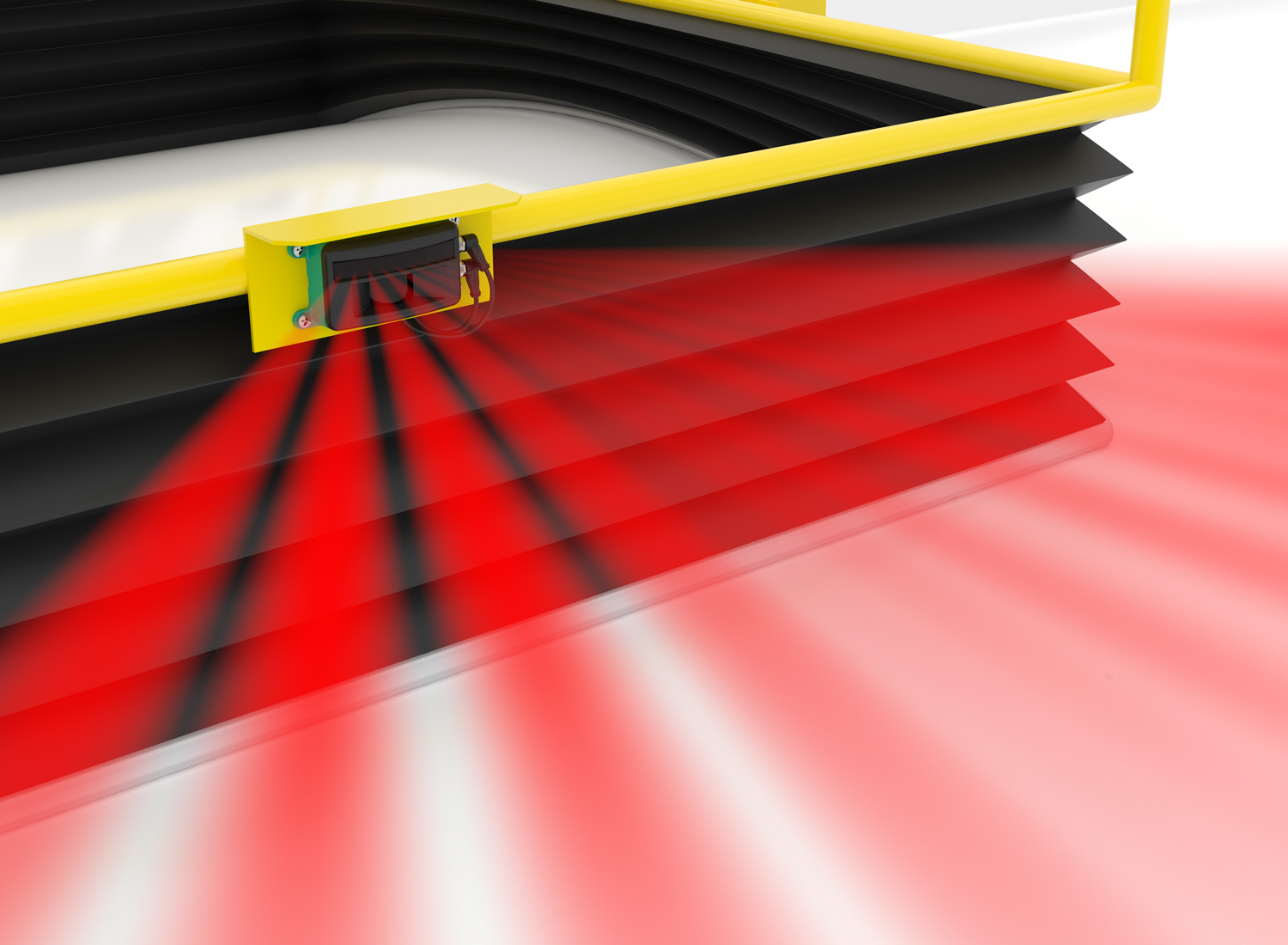
With the proven Pulse Ranging Technology and its eleven LEDs, the R2100 delivers precise measurement results and thus ensures reliable collision protection.
Pepperl+Fuchs designed the R2100 using the proven Pulse Ranging Technology—PRT for short—which is also featured in the rotating R2000 2-D LiDAR sensor. The R2100 emits light pulses from eleven LEDs arranged next to each other. These are reflected from the target object to the device receiving unit. The sensor electronics use the duration of the pulses to determine the distance to the object—twenty times per second. The whole sequence happens completely without wear and failure-prone mechanics and without moving parts. Accordingly, the 2-D LiDAR sensor is resistant to external mechanical influences. The LEDs do not harm eyes and can therefore be used with no restrictions. Safeguards are used where personnel move in the measuring range.

"It would have been a much more complex and intricate task with other sensor types or with one-dimensional measuring principles. A large number of sensors would have been necessary to achieve the same effect, which in turn would have meant a lot more installation and assembly work," says Busch. The smart design of the R2100 enables the space-saving incorporation into applications. It can be easily integrated into the automation solution via CANopen interface.
No Measurement Errors
The eleven transmitting LEDs are arranged such that the sensor scans a sensing range with an opening angle of 88 degrees. Measurement errors that typically occur with a point-shaped, one-dimensional detection of irregular surfaces, are not a concern. The object is reliably detected, even with severe vibrations and shocks. Compared to conventional laser scanners, the large light spots of the LEDs ensure more precise object detection and contour detection on irregular and curved surfaces, as on the fuselage, wings, or engines.
A total of five R2100 sensors are mounted on the outside of the working platform. Their scanning angles monitor the area in front, under, and at the sides of the platform. This allows them to keep an eye on the aircraft fuselage every time the assembly basket is moved. 'When it approaches the fuselage at a distance of one meter, the control panel automatically switches to slow travel,' says Koempel, explaining the safety function. 'The system will stop completely at a distance of less than 0.5 meters.'
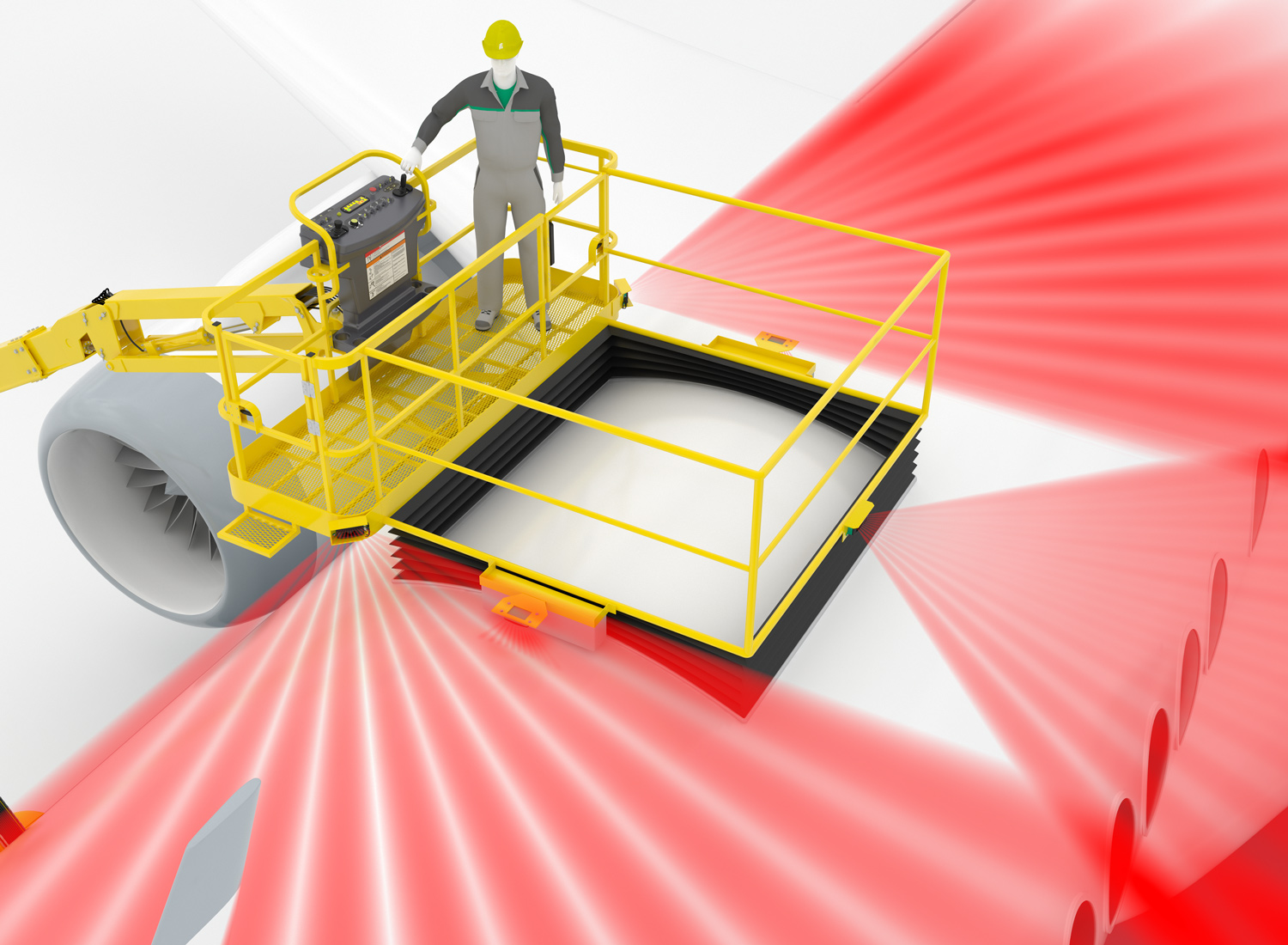
Five R2100 sensors are mounted on the outside of the working platform, monitoring the area in front, under, and at the sides of the platform.
This allows the basket to be safely moved to the working position just above the aircraft. A rubber bellows is placed on the outer skin of the machine. Personnel stand on a small ramp, secured by a door, while driving to the workstation. The rest of the working platform is open at the bottom. When the final position is reached, the door can be opened and the personnel enter the fuselage to mount devices like radar antennas. The bellows ensures that loose parts cannot roll down while work is being carried out.
Tailored Safety Concept
The stringent safety regulations require another precaution, in addition to the collision protection: The vehicle that carries the telescopic arm and the working platform must be stable and safe when in use. The permissible position of the chassis is determined by the position of the working platform and the height and width of the extended telescopic arm. To prevent the vehicle from tipping over, mandatory and reliable inclination angle detection of the vehicle is a prerequisite to ensure safe operation. This protection is provided by the F99 inclination sensor from Pepperl+Fuchs. It detects any angular deviation of the vehicle from the horizontal position. The sensor will send the signal to the safety circuit if a certain value is exceeded.
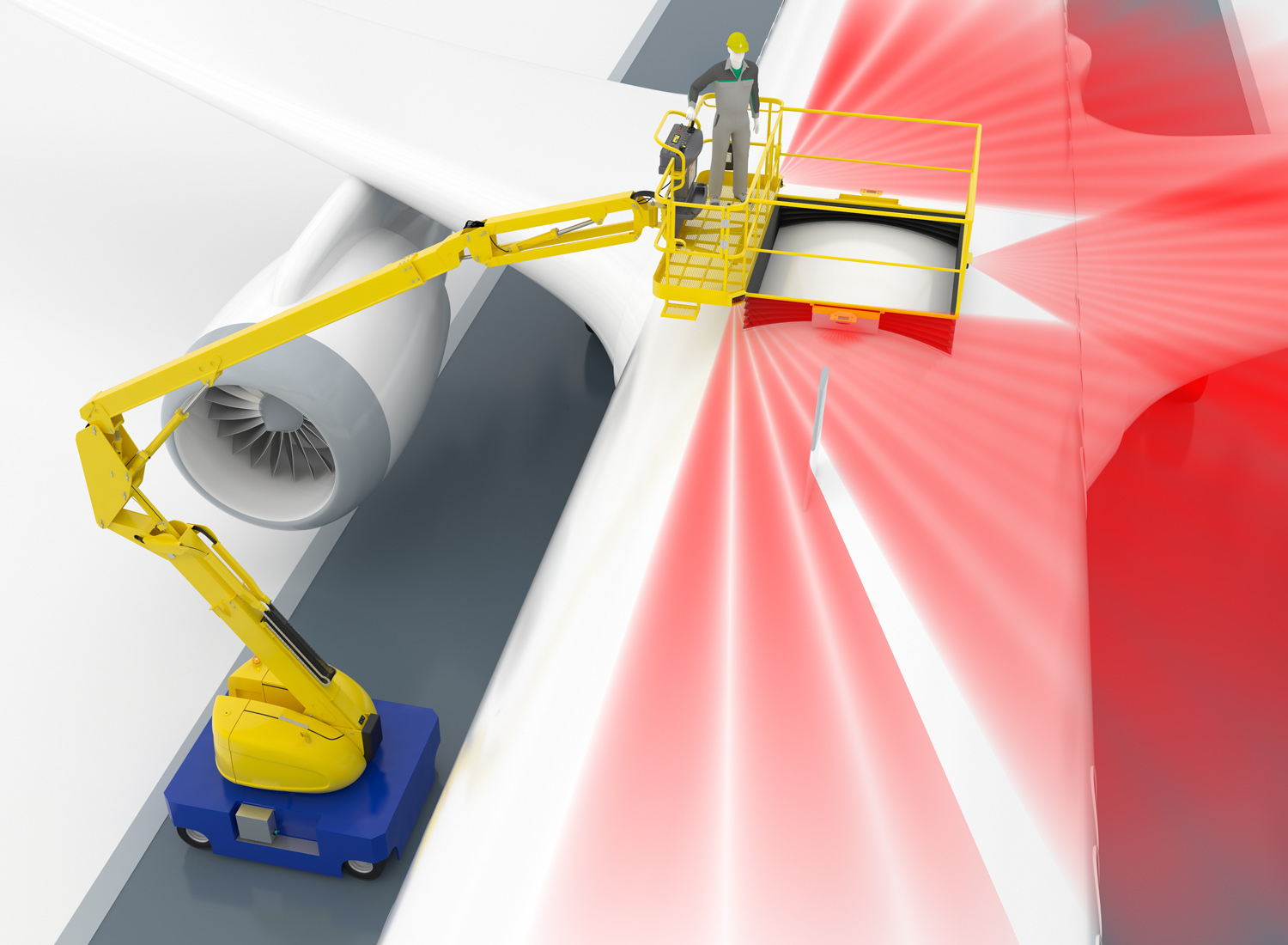
In addition to the R2100 2-D LiDAR sensors for collision protection, an inclination sensor of the F99 series ensures that the mobile work platform is always in a reliable and stable position and prevents it from tipping.
"There is no inclination sensor on the market that alone can meet the strict requirements in terms of safety and robustness," explains Stefanie Arnold, New Business Development Manager at Pepperl+Fuchs, who is responsible for safety concepts. "This is only possible within the framework of a safety concept. We therefore developed a customized solution for this application, which allows use up to the required level of protection performance level c (PL c)," adds Arnold.
Where risk is present for personnel working with machinery, the valid international standards place exacting requirements on technical safety precautions. The ISO standard 13849 defines safety levels as performance levels. The greater the risk, the higher the required level for the technology used. "There is a trend toward using safe assistance systems not only in aviation, but also in all other critical areas of working platforms," emphasizes Arnold.

Reliable Data Flow with Diagnostics
An absolutely reliable, rugged sensor is required to detect inclinations. The F99 inclination sensor fulfills this requirement in every respect. It boasts a housing suitable for outdoor use with IP68/69K degree of protection and is approved for public road traffic. A well-conceived assembly concept and flexible parameterization options allow perfect customization to the respective application.
The second requirement for secure operation is a guaranteed, reliable flow of data. Here, the Pepperl+Fuchs team has been able to draw on the detailed expertise of the entire company, including sensor technology and communication technology. The latter is a crucial aspect, not least in the case of the required diagnostic functions. The inclination sensor regularly sends a heartbeat signal via the CANopen interface. This heartbeat is used by the control panel to detect that the device is working—even if it has no critical value to report. The node guarding function allows active querying of the control panel, and a check of the connected nodes. This ensures the diagnosis required for PL c.
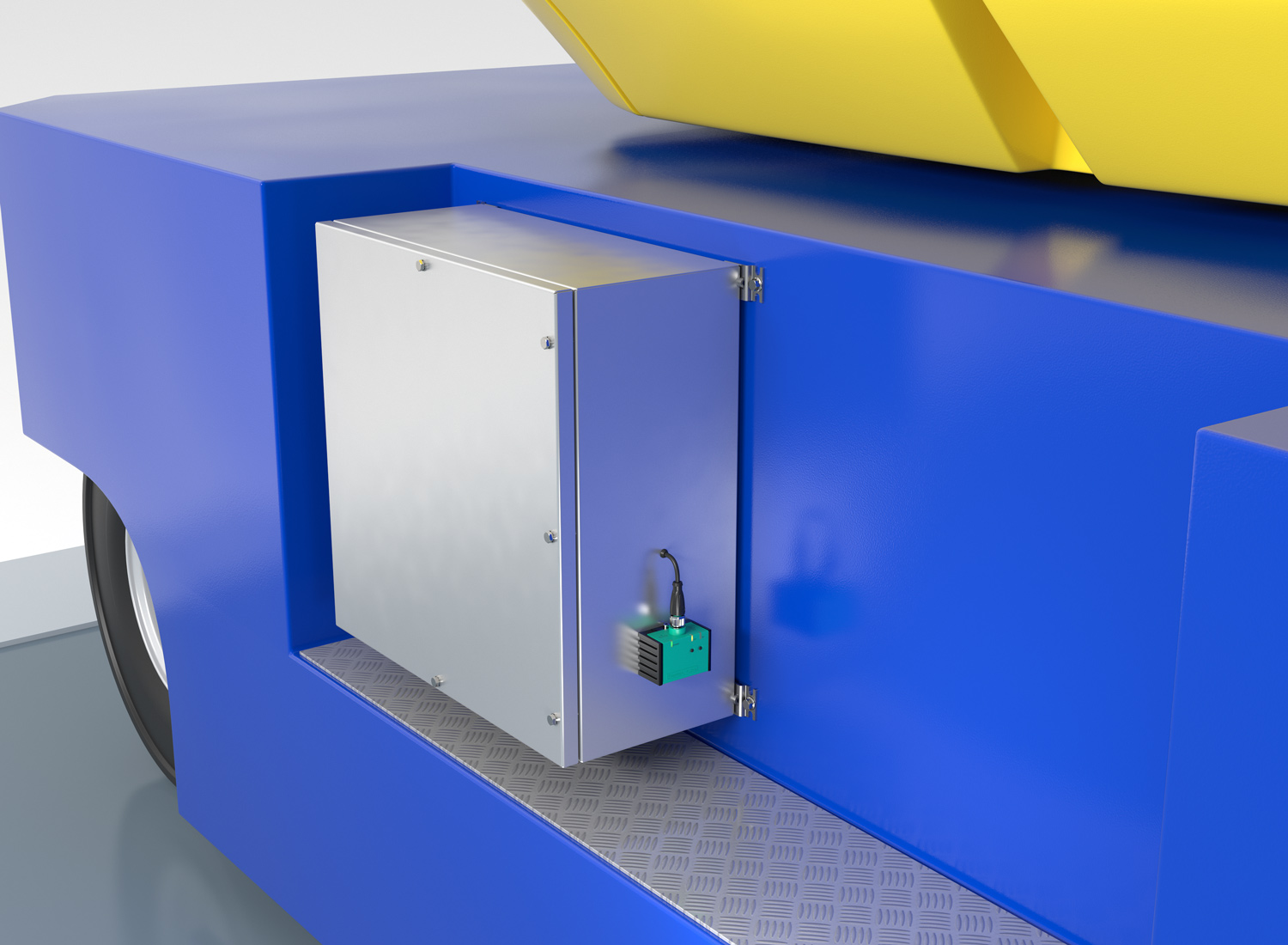
As part of the holistic safety concept, the F99 inclination sensor signals in real time the safe positioning of the vehicle when the telescopic arm extends and the working platform is moved.
Combined Expertise
'We can develop, implement, and certify such safety concepts for other sensors and applications. The solution always comes from one source here,' underlines Arnold. Christian Koempel sees the combined expertise of Pepperl+Fuchs as a major advantage of this partnership: 'We have access to a huge portfolio of devices and, if required, receive product samples for our practical developments in the shortest possible time. This means a short service path to viable solutions, and we get all the support we need—even with a quantity of one that is often found in our tailor-made machines.'


